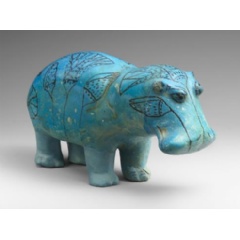Met Museum Celebrates 100th Anniversary of Its Mascot "William"

Two small sculptures—an ancient Egyptian faience hippopotamus and a 20th-century American glazed earthenware work that it inspired—have been juxtaposed at The Metropolitan Museum of Art in the small installation Conversation between Two Hippos, on view through April 1, 2018, in the Lila Acheson Wallace Galleries of Egyptian Art (Gallery 107). The display celebrates the 100th anniversary of the Museum’s acquisition of the faience hippo. Nicknamed “William,” the sculpture is the unofficial mascot of The Met. In conjunction with the anniversary, new content about the sculpture will be added to the Museum’s website this fall, and diverse events for Museum visitors have been organized for the weekend of November 17–19.
Created in the Middle Kingdom (Dynasty 12, reign of Senwosret I–Senwosret II, ca. 1961–1878 B.C.) and excavated in 1910, the exhibition’s ancient Egyptian faience hippopotamus was acquired by The Met in 1917. The origin of its nickname can be traced to a 1931 story in the British humor and satire magazine Punch about a family that consults a color print of The Met’s hippo—which it calls “William”—as an oracle. Subsequently, the story was reprinted in The Metropolitan Museum of Art Bulletin.
Hippopotamus figurines were popular in Egypt’s Middle Kingdom, when they were deposited in tombs to supply the deceased with regenerative powers. The surfaces of the sculptures were often painted with lotus flowers, which were part of the animal’s natural habitat and additionally symbolized rebirth. Because of the hippopotamus’s dangerous nature, and the ancient Egyptian belief that depictions could come to life, three of the sculpture’s legs were probably broken on purpose in antiquity, rendering the animal immobile.
American artist Carl Walters (1883–1955) admired and studied the collection of ancient Egyptian art at The Met. His robust hippo sculpture (a recent acquisition of the American Wing) is decorated with foliate and scroll motifs; both the form and design were likely inspired by the faience figures he encountered on his visits to the museum. Walters introduced the distinctive combination of bright turquoise glaze over black underglaze decoration in the early 1920s, which later became known as “Walters blue.”
Programs and Events
On a regular basis throughout the months of September, October, and November, new material about “William” will be added to The Met website. Included will be a 360-degree panorama of the sculpture, a video, MetKids blogposts, Now at the Met blogposts, and an essay. An interactive social media activity for all ages, imagining the conversation between the hippos, will be launched on Facebook.
In the Museum’s Thomas J. Watson Library, the 1931 Punch article and the 1931 reprint in The Met Bulletin will be displayed Friday and Saturday, November 17 and 18.
The weekend of activities will begin on Friday, November 17, with a “Conversation with a Curator” (6:30 and 7 p.m.).
This event is part of MetFridays: New York’s Night Out.
Programs on Saturday, November 18, will include a series of 15-minute pop-up chats led by The Met’s curators of Egyptian art and other specialists (12:30, 1:30, 3:30, and 4:30 p.m.); an “Ask the Curator” station (noon–5:30 p.m.); and a gallery activity for children participating inArt Trek or Start with Art at The Met (11 a.m. and 2 p.m.) . At the Museum’s Nolen Library, Storytime—a program for children ages 3–6—will feature stories about “William” and other hippos (3–3:30 p.m.)
On Sunday, November 19 (11 a.m.–12:30 p.m.), children with learning or development disabilities and accompanying friends and family members will enjoy Musical Zoo—a gallery tour and art activity. This event is part of The Met Discovery program, which is celebrating its 30th anniversary, and is free with Museum admission. (Reservations are required. Contact 212-650-2010 or access@metmuseum.org).
For Education program funders, visit metmuseum.org/educationfundingsupport.
Throughout the weekend, a “William”-themed cookie and a specialty cocktail will be available for purchase in the Museum’s American Wing Café and Great Hall Balcony Bar, respectively.
“William”-themed merchandise has been available at The Met Store since 1927, when the Store launched a line of color collotype print reproductions of works in the collection. The first 3D reproductions of “William” were added in 1952, with other items to follow. This year, to celebrate the anniversary of “William,” new merchandise—ties, a scarf, tote bag, and holiday ornament among other gifts—will be added. The full selection can be found athttp://store.metmuseum.org/icat/lpwilliam
( Press Release Image: https://photos.webwire.com/prmedia/6/214492/214492-1.jpg )
WebWireID214492
This news content was configured by WebWire editorial staff. Linking is permitted.
News Release Distribution and Press Release Distribution Services Provided by WebWire.